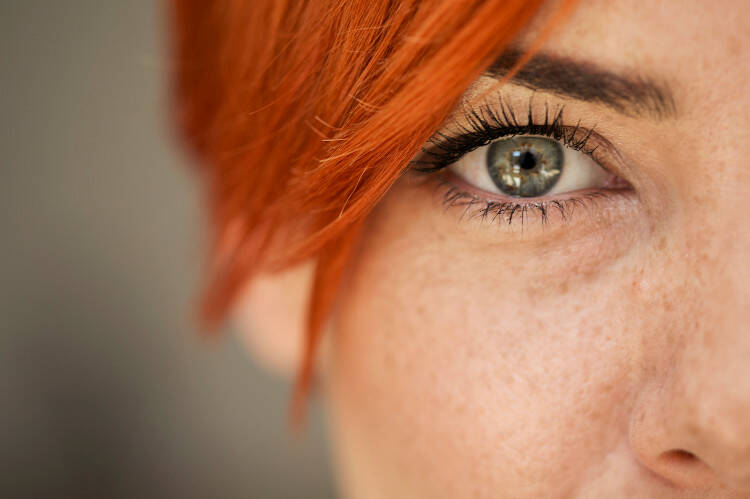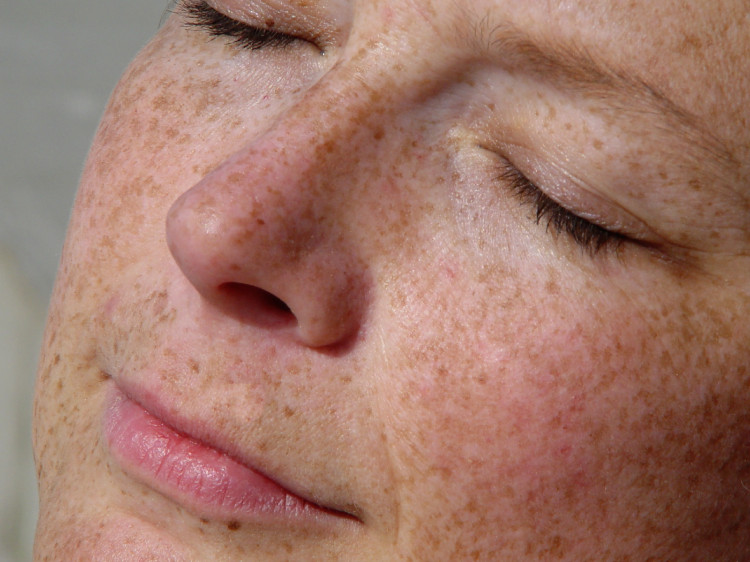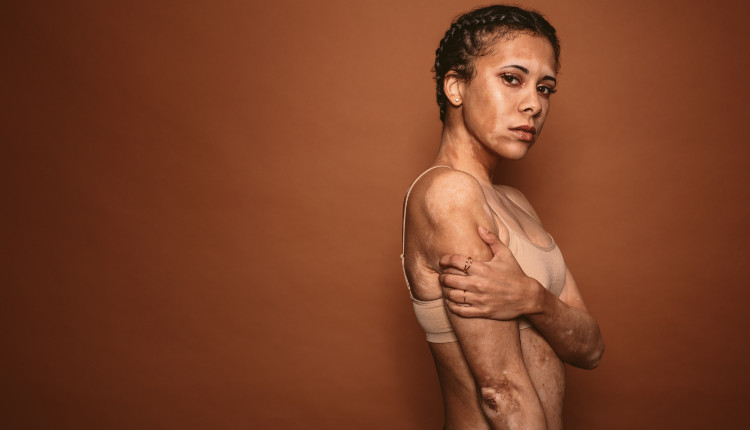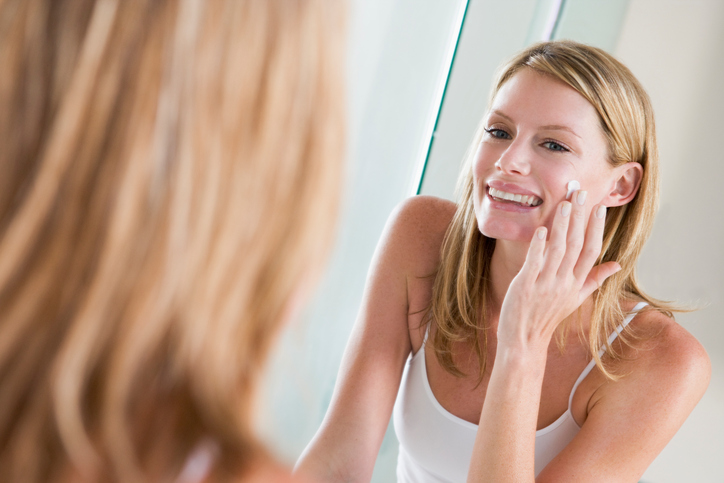Sun and pigment spots: what helps to remove them? + Causes

They appear on the body, usually on the face, neck, shoulders and décolletage. Unpleasant pigment spots are a pigmentation disorder of melanin (skin pigment). The most common are hyperpigmentation (excess skin pigment), which causes patches of yellow-brown to brown colour. Rarer are hypopigmentation (not enough skin pigment) to depigmentation (loss of skin pigment), which creates white islands on the skin. Dark, or light, can spoil the mood.
Article content
With the first rays of the sun, unsightly pigment spots start to appear. They become more and more pronounced and can't be hidden even under a layer of good make-up. Why they appear is well known. There are several causes. The hardest part is the treatment.
Skin and skin discolouration
The colour of our skin depends on the brown to black pigment grains of a skin pigment called melanin. It is found in the skin's connective skin cells in the deeper layers of the skin - the melanocytes. To some extent, it protects the skin from dangerous UV radiation and the formation of free radicals.
It is also found in hair and in the retina of the eye, where it determines the colour of hair and eyes. Different human races have different amounts and types of pigments in their bodies. Even in people of the same race, the darkness of the skin depends on the amount of pigment grains, the depth of their deposition and the blood supply to the skin.
Melanin is divided into two basic types of pigment, which are found in different amounts in different people.
- Eumelanin is a dark brown to black pigment. It predominates in people with darker skin phototypes, which it protects from radiation.
- Pheomelanin is a brownish red to red pigment. It is found in increased amounts in people with a light skin phototype and in red-haired people. This type of pigment does not protect the skin from radiation, forms free radicals and is dangerous to humans.
How does the skin react to sunlight?
Sunlight is a source of dangerous UV rays. These penetrate the deeper layers of the skin and affect it (sunburn, pigment spots, skin cancer).
In addition to the synthesis (production) of vitamin D, which protects the skin from free radicals, they also have harmful effects. These are manifested when excessive sun exposure occurs at the same time as sun allergy and other skin diseases.
The sun's rays (and tanning bed radiation) cause changes in DNA by damaging the bases and polynucleotide chains. They slow down cell division (cell multiplication) while causing mutations and chromosome aberrations.
They deactivate enzymes inside cells and are responsible for protein denaturation.
DNA damage is manifested by the excessive production of melanin, which is unevenly deposited in the skin. The aim of this overproduction of skin pigment is to protect the skin, especially in areas that are overexposed to the sun (face, décolleté, shoulders).
This causes the unsightly, mostly brown-coloured islet spots we call pigment spots.
Pigment spots in children
Pigmentation disorders can also affect children for the same reasons as adults. However, this is a rarity in children, as their young skin has not yet been damaged and exposed to negative factors for a long time.
Pigment spots in children are therefore rare and should preferably be caused by a pathology other than sun exposure.
What are the different pigmentation disorders that can bother you?
Disorders of pigment granule deposition can manifest externally in different people in different ways based on the action of different interacting mechanisms that may also contribute to pigment spots in addition to sun exposure.
Thus, the sun is not the only cause of disproportionately coloured skin, but its effect can intensify the spots. These may be darkly coloured, which is known as hyperpigmentation (chloasma). Islets with fewer pigments may also form, i.e. areas of skin that are paler than on other parts of the body - hypopigmentation.
Skin pigment may also be completely absent - depigmentation.
Dark pigment spots - hyperpigmentation

Hyperpigmentation is caused by excessive melanin production and occurs in various places on the body. It is most common on the face, neck, décolletage and shoulders. It is a sharply defined, brown-coloured patch of irregular shape. It does not rise above the surface of the skin and is smooth flush with the skin surface.
Their colour intensity varies from light brown to dark, which is difficult to cover with make-up.
Physiological (natural) hyperpigmentation:
1. Melanism is a genetically determined skin coloration. In melanism, people have brown skin, usually brown eyes and brown or darker hair. They tan faster in the sun and the tan is not red.
They are less likely to burn quickly. They are also less likely to develop pigment spots.
2. Periorbital hyperpigmentation is hereditary hyperpigmentation occurring in the upper and lower eyelid area. It intensifies with age. It does not cause any other problems.
3. Mongolian macula occurs most commonly in Mongolians and African Americans, hence the name. It also occurs to a lesser extent in Turks and Asians. It is a grey-black, flat and smooth hyperpigmented macula. It is formed during intrauterine development when melanocytes become trapped in the skin.
The predilection sites are the back and buttocks. With age, the patch gradually fades and loses intensity.
Pathological hyperpigmentation
1. Chloasma (melasma) gravidarum are pigmented spots that occur simultaneously during pregnancy or after the birth of a baby. They occur as a result of hormonal changes in pregnant women, predominantly on the face in the forehead, temples and cheekbones as map-like brown spots.
In some cases they disappear after pregnancy, in others they persist. During pregnancy, hyperpigmentation can be observed simultaneously in the external genital area, the nipples and the so-called linea negra (line of pregnancy running from the navel to the pelvis).
This is the hyperpigmentation of the linea alba (white line), which every woman has in this area and may not be visible until pregnancy.
2. Chloasma hormonale is a hyperpigmentation that occurs as a result of hormonal changes. It is most often found in young girls in connection with the use of contraceptives. In many cases, on the other hand, it appears after discontinuation.
Chloasma hormonale also includes chloasma gravidarum, caused by hormonal changes during and shortly after pregnancy. Women can't breathe a sigh of relief even later when unsightly spots appear during menopause - so-called age spots. The face is most often affected (as with pregnancy spots).
However, hormone-related pigment spots also occur with various hormonal diseases or with treatment with hormone-based preparations.
3. Chloasma solare is a very widespread and often mentioned problem in recent times, affecting mostly women and young girls. It is a smooth pigmented patch of irregular shape, usually brown in colour.
They mainly affect those parts of the body that are or have been most exposed to UV rays (sunbathing, solarium). The most common area is the face, often above the upper lip, then the neck, décolleté and shoulders. They are caused by so-called photoaging, which means premature ageing of the skin and damage to the skin due to UV rays. This causes damage to the epidermis.
Photoaging is manifested, in addition to disturbances in uniform skin tone (pigment spots), by loss of elasticity (collagen fibres), loss of hydration, reduced elasticity and premature wrinkle formation.
4. Chloasma medicamentosum does not occur so often. It is caused by the effects of certain drugs, with the exception of chloasma hormonale (contraceptives, hormone therapy).
This includes some drugs that stimulate melanogenesis (excessive melanin production) such as drugs used to treat depression and psychological disorders - chlorpromazine and other anticonvulsants (anticonvulsants - epilepsy, convulsions) or some types of painkillers.
For example, antibiotics containing photosensitising substances are well known. Therefore, the package leaflet also warns the patient taking them to avoid direct sunlight during therapy. Other drugs include antimalarials (for the treatment of malaria) and arsenic.
5. Chloasma cosmeticum are pigment spots resulting from the use of incorrect cosmetics. This can be, for example, a cream or make-up containing photosensitising substances, but also excessive exposure to sunlight at the wrong hours without the use of a cream with SPF.
Currently, the use of activators and bronzers instead of sunscreens is very trendy.
6. Chloasma cachecticorum is very rare. It occurs only in severe diseases, which can be different. Most of the time it is an internal disease. The spots are just an accompanying symptom. They can occur anywhere on the body.
In this case, the underlying disease needs to be treated. Hyperpigmentation or even hypopigmentation is just a trivial aesthetic problem in a patient whose life and health are threatened by a more serious disease such as Addison's disease.
7. Melanoderma is an area of hyperpigmentation occurring anywhere on the body. It is smooth and dark brown in colour. The shape depends on the primary cause of the hyperpigmentation.
The causes are either biological (bacterial or fungal skin diseases) or mechanical (occurring at a site chronically exposed to mechanical pressure and irritation).
Thus, they occur at sites of previous skin inflammation (acne, dermatitis, psoriasis) or mechanically - for example, in obese people in the armpits, under the breasts, between the thighs and in the lower abdomen.
Ephelides is a hereditary disease occurring predominantly in people with red or fair hair. They overproduce melanin due to UV radiation and produce it much faster than others.
Externally, hyperpigmentation appears as multiple round to irregular yellow-brown smooth patches at the level of the skin, ranging from 1 mm to several millimetres in diameter, most commonly on the face, back and shoulders.
They are less common on the décolleté and completely absent on other parts of the body. They are also popularly known as freckles.
Let's look together at all the summer problems:
Our health in summer - sun, heat, injuries and illnesses
Light to white spots - hypopigmentation and depigmentation

Hypopigmentation and depigmentation do not occur to the same extent as hyperpigmentation. These are rarer diseases or aesthetic problems. There is reduced or absent production of brown skin pigment in the affected area.
This produces discontinuous islet patches of white coloration.
As with hyperpigmentation, they are smooth and do not protrude above the surface of the skin. Even for people with this type of depigmentation, the summer and the sun are a nightmare. Although the spots remain white, the rest of the skin darkens due to increased melanin production by sunlight.
This visually accentuates the white spots.
Albinism is a hereditary disease caused by a defect in tyrosinase (an enzyme) found in melanocytes. The result is depigmentation not only of the skin but also of the hair, hair and retina. Albino skin is sensitive to sunlight.
They burn quickly and are more likely to develop skin cancer. Their eyes are also more sensitive to the sun (photophobia), their vision is blurred and their eyes reflect red at night - the cat-eye effect. They are at high risk of blindness.
2. Vitiligo is probably a hereditary disease like albinism. Autoimmune disease may also be involved in the cause. More recently it has also been associated with thyroid disease, anaemia or diabetes.
Extensive islet-shaped and sharply demarcated white patches appear on the whole body of the patient due to the absence of melanocytes in these areas. They are isolated or merge to form large areas.
They become more visible and unaesthetic due to the tanning of the surrounding skin. There is no treatment. Most patients avoid the sun and hide their body under clothing or cosmetic products.
3. Leucoderma is a common name encompassing hypopigmentation to depigmentation due to various pathological causes. Focal loss of pigment is due to destruction of melanocytes in the area due to a pathological process.
This causes local white areas and occurs at the site of previous bacterial skin inflammation, skin fungus, trauma, burn or in a postoperative scar.
Factors aggravating pigment spots
When treating and removing pigment spots, it is important to be careful and avoid factors that could interfere with the treatment and thus worsen the skin condition.
The causes that trigger pigment spots also aggravate the condition and increase the intensity of the pigmentation if they are not removed.
The most common factors aggravating pigment spots:
- sun exposure and other forms of UV radiation (tanning beds)
- hormonal influences - contraceptives, hormone replacement therapy
- photosensitising substances contained in certain drugs or cosmetics (antidepressants)
- alcoholic beverages and cigarettes
- associated diseases, most commonly liver damage
- age
What helps to reduce pigment spots?
Pigment spots are not easy to get rid of. Everyone who has or has had such a problem in the past knows the difficulties and time-consuming treatment. There is a lot of advice on the internet to help us whiten or remove spots.
The testimonials from different people often do not agree. What helped one person, did not help another twenty.
The reason for this is simple. We don't all react the same way to the same treatment. What looks at first glance like a pigmented sunspot, for example, may be a liver spot resulting from disease and severe liver damage.
It is necessary to know the antecedents (what preceded the appearance of the disease), such as previous long years of sunbathing, the use of cheap and poor quality creams, the use of alcoholic beverages in large quantities, certain medications or diseases occurring in the family.
When we know the cause, the treatment is easier. As for pigment spots, due to the overall difficulty, it is advisable to consult a specialist right from the start.
A dermatologist is the best person to consult. He or she can best name the specific problem, pronounce the most likely possible cause and suggest the right therapy or aesthetic procedure.
Natural treatment vs. snail potion

I'm sure you've heard that lemon juice, baking soda and other homemade recipes help to remove pigment spots. Indeed, in some few cases, these substances can lighten the spots, but hardly remove them.
However, there is one homemade recipe that has a pretty good success rate in treating not only spots but also acne and smoothing wrinkles. It is an extract of snail slime.
Snail slime extract was already used by Hippocrates as an ingredient in a mixture for healing wounds and skin inflammations. Later, its effect did not escape the Chilean farmers who noticed that when they harvested snails, the wounds on their hands healed faster.
Recent research has shown that it has incredibly powerful regenerative and healing effects in the treatment of burns. Beauty salons, especially in Japan, have experienced a big boom in snail therapy over the past few years.
The extract is extracted from a substance that the snail begins to secrete when it becomes frightened. This treatment can be used directly by applying the snail to a specific area or face, or with a cream made from extracts of snail slime.
Snail slime regenerates the skin, healing minor injuries, acne, dermatitis or eczema. It also smooths and softens the skin, helping to correct minor scars and reduce wrinkles.
Which creams are the most successful?
Not only slime, but also creams containing snail slime are very effective in treating unsightly dark spots. When choosing a cream, the most important thing to look for is the percentage of slime itself. Cheaper preparations contain only 10% to 15%. More expensive products contain around 80% to 90%.

Light treatment in the fight against pigment spots

For many years people have known about the healing effects of light, but few have put them into practice.
Light therapy, or so-called biolamps, is no stranger to the medical establishment. It has proved its worth especially in dermatology, where it is often used to treat skin inflammation, acne, scars, eczema and pigment spots. It also has a place in surgery to treat post-operative or festering wounds and decubitus.
It helps with muscle, joint, back or post-traumatic chronic pain.
Biolamps use polarised light capable of penetrating the deeper structures of the skin, which then absorbs it. It acts directly on the cells and their membranes. It improves cell metabolism, blood supply to the area, oxygenation and accelerates regeneration of damaged tissues. It is used for a wide range of diseases.
There is a lot of literature that provides manuals and instructions on how long and how often to apply biolamps to a particular tissue or area for a particular disease.
Many people using biolamps have seen a reduction to disappearance of pigment spots without using any other and expensive cosmetics for the problem.
In addition, the light also works against acne, enlarged pores, minor acne scars, eczema and wrinkles. Skin is generally healthier, regenerated and wrinkles and minor scars are reduced after light treatment.
Biolamps can be purchased together with colour filters to achieve the possibility of colour therapy - treatment with colours. These are mainly used to treat depression and psychological disorders.
Dermatology and aesthetic medicine centres
These facilities use the latest technology in taking care of not only the skin but also the body. Using various devices, they can rid you of beauty flaws faster and more effectively. After consulting a specialist, the treatment is more effective.
In some clinics there is the possibility of UV photography, which shows every imperfection still hidden under the surface of the skin (even pigment spots).
Q-SWITCHED Laser is a laser skin treatment method that uses a specially designed laser head. It is suitable for treating acne, enlarged pores, cracked coils, wrinkles.
It removes pigment spots and freckles, even tattoos can be removed with it. It is a breakthrough technology in the treatment of pigment spots with high efficiency.
Laser Pigmet Therapy is a standard laser therapy for the purpose of removing pigment spots with high efficiency. Compared to the latest Q-SWITCHED Laser technology, it is almost half the price.
Chemical peeling is a proven method in removing not only hyperpigmentation but also acne and scars. It is divided into superficial, medium and deep according to the severity of the problem. The latest ones use fruit acids which are more gentle to the skin. Glycolic acid (fruit), other AHA acids are suitable.
For deep peels, trichloroacetic acid is preferred. It is up to the specialist to assess the condition of the skin and the type of peel.
The term photorejuvenation refers to skin treatment using light. It is done in 5 to 6 treatments several weeks apart.
It affects the surface cells to improve acne conditions, tighten enlarged pores and blood vessels, and remove surface pigmentation changes. By heating the device, penetration into deeper skin structures is achieved for more serious problems. With deeper penetration, it acts on collagen and smooths wrinkles.
This allows regeneration and treatment of the superficial and deeper skin structures.
Related










